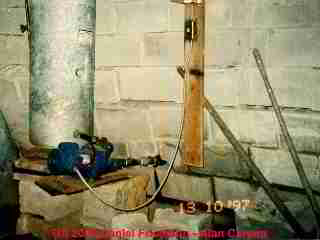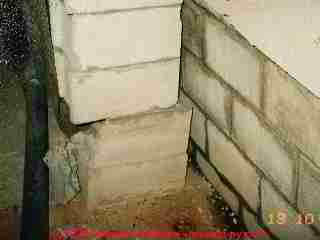 Detect, Diagnose, & Evaluate Combinations of Foundation Movement, Bulges, Cracks, Leaning
Detect, Diagnose, & Evaluate Combinations of Foundation Movement, Bulges, Cracks, Leaning
- POST a QUESTION or COMMENT about diagnosing & repairing complex or combinations of foundation damage & movements that may include multiple ongoing problems or events
Complex foundation movement & cracking:
This section from the Foundation Crack Dictionary discusses in detail the recognition of different types and causes of complex or combined building foundation movement and foundation damage. We distinguish among vertical movement, horizontal movement, leaning, tipping, bending, differential and uniform settlement, earthquake and storm damage, and other foundation damage patterns.
InspectAPedia tolerates no conflicts of interest. We have no relationship with advertisers, products, or services discussed at this website.
- Daniel Friedman, Publisher/Editor/Author - See WHO ARE WE?
Combinations of Foundation Wall Movement, Horizontal & Vertical Crack Patterns Occurring Together
This article series describes how to recognize and diagnose various types of foundation failure or damage, such as foundation cracks, masonry foundation crack patterns, and moving, leaning, bulging, or bowing building foundation walls.
To be used properly, this information must be combined with specific on-site observations at the particular building in order to form a reliable opinion about the condition of that building's foundation.
Anyone having concern regarding the structural stability, safety, or damage of a building, foundation or other components, should consult a qualified expert.
Wall bulge combined with step cracking
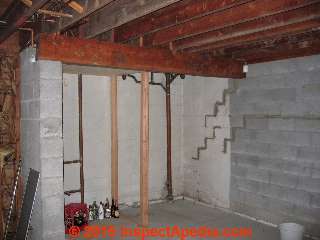
Step cracks
may also be present in bulged, leaning, or horizontally pushed foundation walls if they were constructed of brick or masonry block, or possibly (though less common) of stone.
In fact since the building foundation corners are stronger than the center portions of the foundation wall (the opposing wall at right angle resists movement of the wall being pushed), wall bulges, leans, and cracks tend to occur towards the center of the wall, resulting in step-cracking closer to the ends of the same wall.
In the photograph above, frost push has bulged the center of the foundation wall inwards; as the forces of wet earth and or frost pushing on the upper 1/3 of this foundation wall were applied at the center of the wall, the wall bulged inwards and cracked horizontally at the point of most pressure.
As the same forces causing this wall to bend were exerted closer to the building corners, the wall cracked in the step-crack pattern clearly marked in this picture by the "repairs" which have been done by filling the cracked joints.
If the total amount of wall movement was minor and if the outside source of pressure (water and frost) has been corrected, further repair or reinforcement may not be needed.
Combinations of Foundation Wall Movement During Structural Foundation Collapse
In this collapsing foundation illustration, the masonry block wall has bulged inwards, portions are leaning inwards, and some of the courses of masonry blocks have slid horizontally to extend over their neighbors.
All three movements are present, and of course this wall needs to be re-built.
If you think of a concrete block wall as a stack of "shoe boxes" that you're holding between your hands, and if your friend begins to push inwards on the middle shoe box, you can keep the stack of boxes intact for a while.
But eventually your accomplice applies enough horizontal pressure to the center box that the stack begins to bend. W
hen the bending stack of boxes (or concrete blocks) bends inwards far enough to pass a critical point, the whole stack simply pops inwards and collapses.
This is how a concrete block wall can collapse suddenly when pressure on it builds past a critical point. (
The same wall, if reconstructed with the addition of vertical steel reinforcing rods and concrete will be much stiffer against the same forces.)
Examples of Flood Damage to Building Foundations
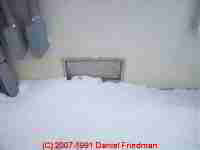
Flood damaged building foundation walls:
just as earth pressure or the increased pressure from wet earth can lead to foundation damage or even collapse, flooding around buildings can lead to foundation damage or collapse from a combination of pressure on foundation walls and perhaps loosening of supporting soils.
In flood prone areas local building codes may call for the installation of flood ports on building foundation walls to reduce the risk of building collapse.
The principle of the flood vent is simple: in response to high water surrounding a building the flood vent opens to permit water to enter the building basement or crawl space, thus equalizing pressure on both sides of the foundation and reducing the chances of foundation collapse.
See FLOOD DAMAGED FOUNDATIONS for details about and photographs of flood-damaged building foundation walls.
Examples of other step cracks occurring in masonry walls or masonry foundations
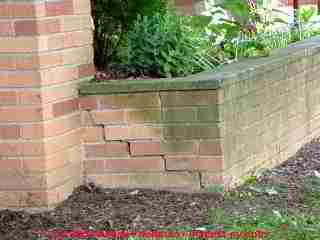
Other step cracks
will of course also occur in building masonry block foundation walls and in brick masonry walls that are not leaning or bulging particularly, where frost or settlement have been causing an "up and down" movement in the foundation or footing.
We will also encounter step cracks where earth pressure or frost have pushed such a wall horizontally, breaking the masonry courses near a corner or wall-end in a stair-step pattern such as we see in this little example of water and frost damage to a brick retaining wall. or select a topic from the closely-related articles below, or see the complete ARTICLE INDEX.
...
Continue reading at FOUNDATION SETTLEMENT or select a topic from the closely-related articles below, or see the complete ARTICLE INDEX.
Or see these
Recommended Articles
- FOUNDATION BULGE or LEAN MEASUREMENTS explains a simple method for determining how much bulge or lean is present in a foundation or wall.
- FOUNDATION CRACK DICTIONARY for a discussion of the diagnosis of specific crack patterns in masonry
- FOUNDATION MOVEMENT ACTIVE vs. STATIC helps determine if the foundation movement is ongoing.
Suggested citation for this web page
FOUNDATION MOVEMENT COMBINATIONS at InspectApedia.com - online encyclopedia of building & environmental inspection, testing, diagnosis, repair, & problem prevention advice.
Or see this
INDEX to RELATED ARTICLES: ARTICLE INDEX to BUILDING STRUCTURES
Or use the SEARCH BOX found below to Ask a Question or Search InspectApedia
Ask a Question or Search InspectApedia
Questions & answers or comments about diagnosing & repairing complex foundation damage & movements that may include multiple ongoing problems or events.
Try the search box just below, or if you prefer, post a question or comment in the Comments box below and we will respond promptly.
Search the InspectApedia website
Note: appearance of your Comment below may be delayed: if your comment contains an image, photograph, web link, or text that looks to the software as if it might be a web link, your posting will appear after it has been approved by a moderator. Apologies for the delay.
Only one image can be added per comment but you can post as many comments, and therefore images, as you like.
You will not receive a notification when a response to your question has been posted.
Please bookmark this page to make it easy for you to check back for our response.
IF above you see "Comment Form is loading comments..." then COMMENT BOX - countable.ca / bawkbox.com IS NOT WORKING.
In any case you are welcome to send an email directly to us at InspectApedia.com at editor@inspectApedia.com
We'll reply to you directly. Please help us help you by noting, in your email, the URL of the InspectApedia page where you wanted to comment.
Citations & References
In addition to any citations in the article above, a full list is available on request.
- "Concrete Slab Finishes and the Use of the F-number System", Matthew Stuart, P.E., S.E., F.ASCE, online course at www.pdhonline.org/courses/s130/s130.htm
- Sal Alfano - Editor, Journal of Light Construction*
- Thanks to Alan Carson, Carson Dunlop, Associates, Toronto, for technical critique and some of the foundation inspection photographs cited in these articles
- Terry Carson - ASHI
- Mark Cramer - ASHI
- JD Grewell, ASHI
- Duncan Hannay - ASHI, P.E. *
- Bob Klewitz, M.S.C.E., P.E. - ASHI
- Ken Kruger, P.E., AIA - ASHI
- Bob Peterson, Magnum Piering - 800-771-7437 - FL*
- Arlene Puentes, ASHI, October Home Inspections - (845) 216-7833 - Kingston NY
- Greg Robi, Magnum Piering - 800-822-7437 - National*
- Dave Rathbun, P.E. - Geotech Engineering - 904-622-2424 FL*
- Ed Seaquist, P.E., SIE Assoc. - 301-269-1450 - National
- Dave Wickersheimer, P.E. R.A. - IL, professor, school of structures division, UIUC - University of Illinois at Urbana-Champaign School of Architecture. Professor Wickersheimer specializes in structural failure investigation and repair for wood and masonry construction. * Mr. Wickersheimer's engineering consulting service can be contacted at HDC Wickersheimer Engineering Services. (3/2010)
- *These reviewers have not returned comment 6/95
- Building Pathology, Deterioration, Diagnostics, and Intervention, Samuel Y. Harris, P.E., AIA, Esq., ISBN 0-471-33172-4, John Wiley & Sons, 2001 [General building science-DF] ISBN-10: 0471331724 ISBN-13: 978-0471331728
- Diagnosing & Repairing House Structure Problems, Edgar O. Seaquist, McGraw Hill, 1980 ISBN 0-07-056013-7 (obsolete, incomplete, missing most diagnosis steps, but very good reading; out of print but used copies are available at Amazon.com, and reprints are available from some inspection tool suppliers). Ed Seaquist was among the first speakers invited to a series of educational conferences organized by D Friedman for ASHI, the American Society of Home Inspectors, where the topic of inspecting the in-service condition of building structures was first addressed.
- Design of Wood Structures - ASD, Donald E. Breyer, Kenneth Fridley, Kelly Cobeen, David Pollock, McGraw Hill, 2003, ISBN-10: 0071379320, ISBN-13: 978-0071379328
This book is an update of a long-established text dating from at least 1988 (DJF); Quoting:
This book is gives a good grasp of seismic design for wood structures. Many of the examples especially near the end are good practice for the California PE Special Seismic Exam design questions. It gives a good grasp of how seismic forces move through a building and how to calculate those forces at various locations. THE CLASSIC TEXT ON WOOD DESIGN UPDATED TO INCLUDE THE LATEST CODES AND DATA. Reflects the most recent provisions of the 2003 International Building Code and 2001 National Design Specification for Wood Construction. Continuing the sterling standard set by earlier editions, this indispensable reference clearly explains the best wood design techniques for the safe handling of gravity and lateral loads. Carefully revised and updated to include the new 2003 International Building Code, ASCE 7-02 Minimum Design Loads for Buildings and Other Structures, the 2001 National Design Specification for Wood Construction, and the most recent Allowable Stress Design. - Building Failures, Diagnosis & Avoidance, 2d Ed., W.H. Ransom, E.& F. Spon, New York, 1987 ISBN 0-419-14270-3
- Domestic Building Surveys, Andrew R. Williams, Kindle book, Amazon.com
- Defects and Deterioration in Buildings: A Practical Guide to the Science and Technology of Material Failure, Barry Richardson, Spon Press; 2d Ed (2001), ISBN-10: 041925210X, ISBN-13: 978-0419252108. Quoting:
A professional reference designed to assist surveyors, engineers, architects and contractors in diagnosing existing problems and avoiding them in new buildings. Fully revised and updated, this edition, in new clearer format, covers developments in building defects, and problems such as sick building syndrome. Well liked for its mixture of theory and practice the new edition will complement Hinks and Cook's student textbook on defects at the practitioner level. - Guide to Domestic Building Surveys, Jack Bower, Butterworth Architecture, London, 1988, ISBN 0-408-50000 X
- "Avoiding Foundation Failures," Robert Marshall, Journal of Light Construction, July, 1996 (Highly recommend this article-DF)
- "A Foundation for Unstable Soils," Harris Hyman, P.E., Journal of Light Construction, May 1995
- "Backfilling Basics," Buck Bartley, Journal of Light Construction, October 1994
- In addition to citations & references found in this article, see the research citations given at the end of the related articles found at our suggested
CONTINUE READING or RECOMMENDED ARTICLES.
- Carson, Dunlop & Associates Ltd., 120 Carlton Street Suite 407, Toronto ON M5A 4K2. Tel: (416) 964-9415 1-800-268-7070 Email: info@carsondunlop.com. Alan Carson is a past president of ASHI, the American Society of Home Inspectors.
Thanks to Alan Carson and Bob Dunlop, for permission for InspectAPedia to use text excerpts from The HOME REFERENCE BOOK - the Encyclopedia of Homes and to use illustrations from The ILLUSTRATED HOME .
Carson Dunlop Associates provides extensive home inspection education and report writing material. In gratitude we provide links to tsome Carson Dunlop Associates products and services.


